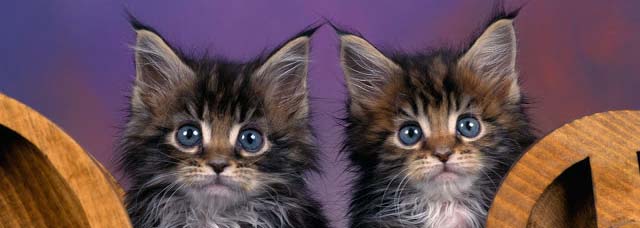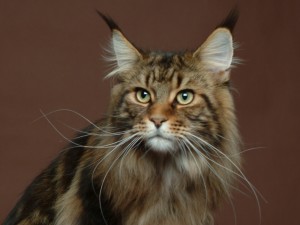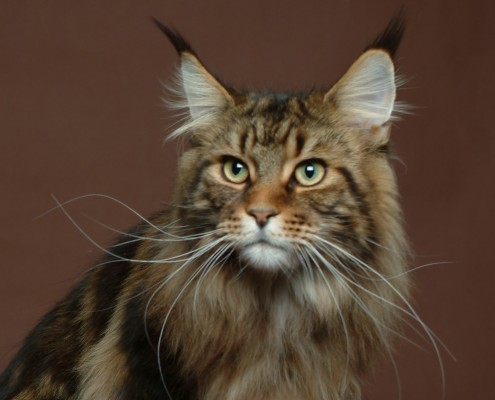Maine Coon

Meoww!!
Maine Coons can rival the size of small dogs and are highly intelligent, playful and energetic. They thrive in families that include children and other pets, including dogs. Be aware that they are very dexterous and are capable of using their front paws like raccoons to scoop up food. They like to dunk favorite toys in water bowls. They have been known to stretch up, wrap their front paws on door knobs and open doors.
In 5 Words
- Loving
- Quite
- Gentle
- Soft
- Tender
Snapshot
WEIGHT RANGE:
Male: large: >12 lbs.
Female: medium: 8-12 lbs.
EYE COLOR:
Copper, Green, Gold, Odd-eyed
EXPECTATIONS:
Longevity Range: 9-13 yrs.
Social/Attention Needs: Moderate, High
Tendency to Shed: High
COAT:
Length: Long
Characteristics: Straight
Colors: White, Black, Blue, Red, Cream, Brown, Silver, Tortoiseshell, Bluecream, Golden
Pattern: Solid Color, Tortoiseshell, Bicolor, Tricolor/Calico, Tabby, Smoke, Shaded
Less Allergenic: No
Overall Grooming Needs: High
CLUB RECOGNITION:
Cat Association Recognition:
CFA, ACFA , FIFe, TICA
Prevalence: Common

Characteristics
Learn About the Maine Coon
The ancestral origins of the Maine Coon are unknown. There are only theories and folk tales. One such folk tale involves Marie Antoinette, the Queen of France, who was executed in 1793. Maine Coons have been on this earth for many centuries, they were well documented at being in large numbers at American Cat Shows in the mid 1800’s alongside the other popular breed at the time the Persian cat. Realistically, the ancestors of the Maine Coon probably came to America from Asia and Europe during the 18th century, and probably contain some Angora blood. It may be that the Maine Coon simply evolved from domestic cats that accompanied the early Pilgrims on their voyages from Great Britain. New England cat fanciers began entering their Maine Coons in local cat shows and county fairs during the 1860s. A Maine Coon reportedly won Best in Show at the first major cat show in North America, which was held at Madison Square Garden in 1895. This myth, bolstered by the bushy tail and the most common coloring (a raccoon-like brown tabby) led to the adoption of the name ‘Maine Coon. Another popular theory is that the Maine sprang from the six pet cats which Marie Antoinette sent to Wiscasset, Maine when she was planning to escape from France during the French Revolution. Most breeders today believe that the breed originated in matings between pre-existing shorthaired domestic cats and overseas longhairs (perhaps Angora types introduced by New England seamen, or longhairs brought to America by the Vikings).
First recorded in cat literature in 1861 with a mention of a black and white cat named ‘Captain Jenks of the Horse Marines,’ Maine Coons were popular competitors at early cat shows in Boston and New York. A brown tabby female named ‘Cosie’ won Best Cat at the 1895 Madison Square Garden Show.
The breed made a slow but steady comeback starting in the 1950s. In 1953, the Central Maine Coon Cat Club was formed to promote the breed. A small group of dedicated breeders helped the Maine Coon regain its stature in the cat fancy, and by 1976 all North American purebred cat registries had accepted the breed for full championship status. The International Society for the Preservation of the Maine Coon was formed in 1976 as well.
The Maine Coon is one of the largest domestic breeds. Males commonly weigh 6-8kg (13-18lb) and females 4-6kg (9-13lb). They have square muzzles, high cheekbones, round eyes, large tufted ears and strong muscular legs. The long, flowing coat is heavy and shaggy, with an obvious ruff around the neck and a plumed, bushy tail. The classic Maine Coon colour is the tabby pattern, but any colour or pattern is acceptable except for the pointed Siamese pattern. This has resulted in the breeding of a wide range of colours and patterns including selfs, bicolours, tortis, tabbies, tabby-tortis (also called torbis), and shadeds.
he Maine Coons are very smart cats and are also known to have “dog like” qualities, they are loyal and tend to choose one person in the family as their “special person”. This breed is well known as the Gentle Giants of the cat world and do have a very kind and gentle outlook on life. Maine Coon is known in the cat fancy as a “gentle giant”, much like the Great Dane is known in the dog fancy by that same nickname. This is an extroverted, outgoing, sociable breed, with a loving nature, a kind disposition and a keen intellect. Most Maine Coons are highly trainable and can easily be taught to walk on a harness and leash. They are affectionate, playful animals that typically get along extremely well with children, other cats and even dogs.They do not constantly pester you for attention, but prefer to “hang out” with their owners, investigating whatever activity you’re involved in and “helping” when they can. They love a game of fetch and are often said to be more dog-like in nature than any breed of cat. They might have little quirks like drinking with their paws, and many Maine Coons are polydactyl, meaning they have extra toes.Maine Coon cats are friendly and gentle, but not too demanding. They could not really be described as ‘lap cats’, although some individuals may enjoy sitting on laps. They get on well with children, dogs and other pets. They are very playful, and have a life-long kittenish disposition. They have a soft, high-pitched, chirping voice.
American sources say that Maine Coons are renowned hunters. Maine Coons have a sweet nature and are very playful and friendly. They enjoy human company. Possibly because of their humble origins they are used to sleeping rough and are often found curled up in the strangest of places. Maine Coons are noted for the delightful quiet chirping sound they make.
Maine Coons have some hereditary health issues that can be of concern, especially if you aren’t cautious about who you buy from. They include hypertrophic cardiomyopathy, hip dysplasia and spinal muscular atrophy, Polycystic Kidney Disease (PKD) and Chronic Gingivitis.
Hypertrophic cardiomyopathy (HCM)
-is the most common form of heart disease in cats. It causes thickening (hypertrophy) of the heart muscle. An echocardiogram can confirm whether a cat has HCM. Avoid breeders who claim to have HCM-free lines. No one can guarantee that their cats will never develop HCM. Maine Coons that will be bred should be screened for HCM, and cats identified with HCM should be removed from breeding programs. Researchers have identified the genetic mutation that causes the development of HCM in the Maine Coon and have developed a genetic test that allows breeders to screen cats before breeding them. Do not buy a kitten whose parents have not been tested for this disease.
Hip dysplasia is a hereditary defect of the hip socket
-It can be mild, causing little or no pain, or it can eventually lead to severe lameness. Maine Coons with hip dysplasia may move slowly or avoid jumping. Depending on the severity of the condition, weight loss, medication or surgery can help to relieve pain. Maine Coons who will be bred should have their hips x-rayed and graded by a veterinary orthopedic specialist at two years of age. Ask the breeder to show evidence that a Maine Coon kitten’s parents have hips that have been rated as fair, good or excellent.
Spinal muscular atrophy
– is caused by the death of spinal cord neurons that activate skeletal muscles of the trunk and limbs, leading to muscle weakness and degeneration. Kittens with SMA walk with swaying rear ends and have difficulty jumping. The disease doesn’t cause pain and the cats can live an otherwise normal life.
Polycystic Kidney Disease (PKD)
-Maine Coon cats are also predisposed to PKD, which also affects many Persian or Persian-related felines. The disease causes cysts on the kidneys. These growths multiply and grow in size as the cat gets older.
Symptoms include weight loss, depression and increased thirst and urination. Owners might also see vomiting. Although PKD is irreversible, it generally progresses slowly. Vets consider ultrasound the most reliable method to diagnose the disorder.
Chronic Gingivitis
-According to Maine Coon Cat Health, Maine coons are genetically predisposed to chronic gingivitis, which is a swelling of the gums that causes a loss of appetite and discomfort for your cat.
Most cats do a good job of grooming themselves and keeping clean. The Maine Coon is a longhaired cat, so you will need to help out with regular brushing. Regular brushing will be beneficial for several reasons. It will help to reduce shedding and also aid in the formation of hairballs. Brushing will help to keep the coat clean and smooth, and reduce the risk of knots forming. We recommend a brush with metal bristles, that also helps detangle hair as it works.
Maine Coons Cat Hairballs
Because Main Coon cats are technically a long-haired cat breed, they can experience problems with many hairballs. Cats can be at risk for intestinal blockage if they suffer from frequent hairballs. Brushing the Maine Coon on a regular basis can prevent excessive hairballs. Regular grooming can decrease shedding and prevent hairballs. Another option is to feed the cat a hairball-specific cat food formula, which can help digest any ingested hair.
Maine Coons Cat Dental Care
Unlike many other cats, Maine Coon cats can be susceptible to periodontal disease. Because gum problems in cats can lead to serious medical problems, it is important to keep an eye on a Maine Coon’s dental health. Toothbrushes specifically made for pets and cat-specific formulated toothpaste can be purchased at pet stores. However, many cats do not like having their teeth brushed and it may take an assistant to complete this task. It is a good idea to brush the cats teeth at least once per week.
The Maine Coon has a heavy, shaggy coat that’s silky to the touch. It rarely mats and weekly combing is all that’s needed to care for it. Combing removes the dead hairs that would otherwise be ingested by your cat when he bathes himself, resulting in hairballs. Trim the nails as needed, usually every 10 days to two weeks. Cats can be prone to periodontal disease, so brush the teeth at home with a vet-approved pet toothpaste and schedule regular veterinary dental cleanings.






